Blog
2020.11.09
German language
The Mystery of Numerals in German
When working as a translator or interpreter, you need to be careful about the expression of numbers in foreign languages. You may think that numbers are universal no matter which language. It is true that Arabic numerals (1,2,3…) are commonly used throughout the world and there is little room for misunderstanding when they are written as digits.
However, numerals and the numerical system, which expresses numbers verbally, are often confusing because each language has its own way of expressing numbers and each language uses a different system of ordinal numbering (decimal, duodecimal, twentieth, etc.).
Is “21” 20 + 1 or 1 + 20?
Japanese uses the decimal system, which is said to be a relatively simple and rational form of numbering. However, German numerals have a unique expression. Since German is in the same language family as English, there are similarities between the numerals 1 to 9.
| 1 | 2 | 3 | 4 | 5 | 6 | 7 | 8 | 9 | 10 | |
| English | one | two | three | four | five | six | seven | eight | nine | ten |
| German | eins | zwei | drei | vier | fünf | sechs | sieben | acht | neun | zehn |

Expressions from 11 to 19 are similar to those in English: eleven-elf, twelve-zwölf, thirteen-dreizehn… The same linguistic structure is used for the expressions from 11 to 19. However, after 21, German expressions become less straightforward. For example, the German word for 21 is einundzwanzig, a word consisting of three parts: 1 and 20 (ein und zwanzig). The tens digit comes first followed by the ones digit. If it is a three-digit number, it is pronounced in the order of hundreds digit, then the ones digit and finally the tens digit. Larger numbers, such as 58,236 (Achtundfünfzigtausendzweihundertsechsunddreisig), would be read aloud in the order of the thousands digit, the ten thousands digit, the hundreds digit, the ones digit and the tens digits. Second from the left, then first, then third, fifth and finally fourth. Reading numbers in German is complicated.
Why don’t you pronounce the numbers in order from left to right?
There are many theories, but the origins go back as far as 4,000 years ago. In the Indo-European languages, the ancestors of the German language, originally the number one position was written first. As time went on, Arabic numerals were introduced to Germany in the 15th century, and although it was recommended to pronounce the numbers in order from the left side, it did not take hold and the old custom remained.
Thus, there are other languages that pronounce the ones digit first, such as Dutch, Danish, Luxembourgish, Slovene and Arabic. English had a similar practice, but a language reform in the 16th century led to the pronunciation of the word twenty-one. Norwegian likewise abolished the pronunciation method of reading the ones digit first in 1951.
However, if you think about it, the number 13 to 19 in English is also pronounced with the ones digit first.
Long scale, short scale
Even more troublesome with numerals is the difference in the numeration system. In Japanese, the units (ten thousand, billion, trillion) are carried forward every four digits, whereas in Western languages, the units are carried forward every three digits, separated by a comma. These are also known as the decimal system or the thousand-digit system for convenience.
What causes more confusion is the existence of two Western propositional systems, the long scale, which is based on powers of 1000, and the short scale, which is based on powers of one million. The short scale is mainly used in English-speaking countries and Eastern Europe, while the long scale is mainly used in European countries, including France and Germany.
| Long scale (English) | Short scale (German) | |
| 1.000.000 | million | Million |
| 1.000.000.000 | billion | Milliarde |
| 1.000.000.000.000 | trillion | Billion |
| 1.000.000.000.000.000 | quadrillion | Billiarde |
| 1.000.000.000.000.000.000 | quintillion | Trillion |

As you can see from the table, “Billion” in English-speaking countries is 1 billion, but in non-English-speaking countries it refers to 1 trillion. “Trillion” in English-speaking countries refers to 100,000,000,000 and to 1.000.000.000.000.000.000 in non-English-speaking countries.
As you can see, the use of numbers in foreign languages, both spoken and written, can easily lead to misinterpretation and confusion. Our translators are experts in their respective language combinations and familiar with the differences in the numerical systems. You can rest assured that our translations will be correct. Feel free to contact us for a free quotation.
Similar Posts
[jetpack-related-posts]



Leave a Reply